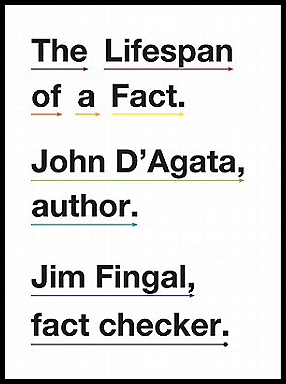“If mirrors were a sufficient means of handling human experience,
I doubt that our species would have invented literature.”
John D’Agata
By Ernest Kearney — In 2003 Harper’s Magazine commissioned John D’Agata to pen an essay about the suicide of a 16-year-old Las Vegas teenager, Levi Presley, who leapt to his death from the observation deck of the Stratosphere Hotel.
D’Agata, a highly touted essayist, delivered fifteen pages entitled What Happens There.
Eventually, Harper’s opted to drop the piece deeming that it was “irrevocably error-ridden.”
Afterward, D’Agata resold the piece to the bimonthly magazine The Believer who assigned Jim Fingal to fact check the article prior to publication.
It began innocently enough with Fingal’s first email to the writer:
“I’ve discovered a small discrepancy
between the number of strip clubs
you say there are in Las Vegas…”
From that point, on the dynamics between the two men was similar to that of the Titanic and the iceberg but without the nicety of the band playing on. It was a classic case of the immovable object meeting the irresistible force; for “object” read D’Agata, for “force” Fingal.
Like a Vegas gambler trying to decide whether to play another hand or quit the game, Presley had sat quietly absorbed in his thoughts for 45 seconds on a ledge 1149 feet above the casino’s tables, before making his choice.
But any such “fact” was meaningless to D’Agata, as he hadn’t written an “article” but composed an essay on the nature of myth in our lives and world; his responsibility was to that composition.
D’Agata refashioned “facts,” shortened details weaving them into his prose as a recurring motif that he desired, for use in netting the deeper truth that laid beneath reality’s shallow surface.
Fingal found the article a massive minefield of fudged facts and manipulated minutiae, with every page awash in a deluge of discrepancies amassing file folders thick with research notes, official documents, graphs, hand drawn diagrams of traffic flows on Vegas’ Boulevards and spreadsheets to catalogue the disputable descriptions, colored commentary, unverifiable quotes, or blatant falsehoods that riddled the article from its first to last sentence with the only inarguable fact being that Levi Presley’s leap had achieved the desired results.
It was a clash of opposing and antagonistic attitudes; D’Agata saw the factual as lacking importance beside his mythic. Facts were to him mere stepping-stones to his own truth. For Fingal, facts were the marble of truth’s shrine.
Some conflicts have stunning longevity; the Serbs and the Croats, the Sunnis and the Shias, the Irish and the British and each other.
So too the essayist and his fact checker.
However the editors, at reaching the end of their patience put an end to this literary bickering and the piece finally came to print.
In 2010.
In 2012 the two men produced a combined neo-epistolary war memoir constructed from seven years’ worth of emails, chronicling their intellectual bloodletting and barefisted ideological brawling over the issue of whether accuracy is negotiable or if truth is rightfully armored in facts or may wear the silken robes of interpretation.
The battle line was clearly marked out on the book’s cover:

In 2018 Jeremy Kareken, David Murrell and Gordon Farrell adapted the narrative of that epic War of the Wordage for the stage.
The playwriting trio has managed to mold the literary source material to fit the needs of the dramatic with a minimum of alterations; they added to the dramatic persona the fictional character of Emily Penrose (Inger Tudor) the editor-in-chief of some unnamed New York glossy favored by the urban cognoscenti, who entrusts a youthful nerdy Fingal (Jonah Robinson) with the responsibility of verifying the veracity of an essay by the cantankerous Hemingwayesque D’Agata (Ron Bottitta).
The trio imposes a rigid deadline of five days, rather than seven years, for Fingal to complete his work, thus corralling the task in a cramped arena that kicks the conflict into high gear.
Otherwise, the drama retains the reality of the conflict between Fingal and D’Agata with his original essay and their actual emails constituting a sizable portion of the play’s dialogue.
The audience is treated to quibbling, questioning, belligerence and abundant sarcasm as Fingal and D’Agata whack and pound at each other with wit and platitudes.
“I’m seeking truth not necessarily accuracy,” bellows D’Agata, striking a pose popular among the denizens of the new cynicoratical America.
For his essay, D’Agata wants Presley’s death “to be more unique.”
There are problems within this play.
D’Agata is a bully. Worst, in this era where the fraudulent fundamentalism espoused by Fox News, QAnon and the MAGA masses threatens to smother our nation’s principles beneath their “My Pillows” of alternative facts, there can be no tolerance for the misjudgment that fact and fiction are merely different “truths.”
Fingal does come off as borderline OCD. In discussing the number of strip joints in Vegas, Fingal finds D’Agata has changed the number to “34” when in fact it was “31.” Asking why, D’Agata flippantly replies “34” has better rhythm in the sentence.
When asked why D’Agata switched an event from the “Boston Saloon” where it occurred, to a bar called “The Bucket of Blood,” D’Agata justifies his decision with the reply the name was more interesting.
Penrose serves to provide the two combatants with a referee-slash-buffer zone, but the character comes across, at points, as somewhat adrift in the play’s conflict giving one the feeling that some essential back story was stripped away from her in the rounds of reworking the show.
At the outset of the play, Penrose expresses her love for D’Agata’s essay, but she seems not to hear the mountain of inaccuracies and flaws Fingal is seeing.
When she tells Fingal he’s doing his job too well, the frustrated fact
checker argues, “I don’t have a codebook that tells me what matters and what doesn’t.”
Penrose shoots back, “There is no codebook, it’s called judgment.”
However, Robinson and Tudor demonstrate the consummate talent to seal shut any cracks in the play’s construction and Bottitta could enthrall an audience with his performance if cast as the goose in the Christmas Carol.
Scenic Designer, Joel David and Video Artist, Nicholas Santiago have fused their skills to produce a superb set, and Director, Simon Levy once more conducts his staging like a true maestro.
Benefiting from the artistry of cast, support crew and Levy the resulting production is so slick that you’ll probably be half way home before realizing that the show you just sat through was a shrewdly well-groomed shaggy dog with no resolution or transformative epiphany arrived at by any of the characters.
Still with some help from the playwriting triplets, Levy and his cast end the evening with a strikingly poignant moment.
The three characters — having exhausted themselves in their round-robin squabbling — sit on a couch facing out, and at Penrose’s urging each one reads from the essay’s closing: the description of Presley atop the Stratosphere.
In contrasting the shambolic raging that preceded, the passages read are rendered with the subtle silence that haiku commands. They are perhaps the only words the audience really hears, or needs to.
Finished, the readers sit motionless like Mi-zaru, Kika-zaru and Iwa-zaru, Buddha’s three wise monkeys.
Seeking the reasoning behind another’s choice is like chasing a chimera. But if that unknowing “truth” must be sought, then we must purge that search of any harm.
And so the performance ends with essayist, fact-checker and editor sitting pensively for nearly a minute as lights dim bringing the stage to black.
* * *
The Lifespan
of a Fact.
Onstage at
The Fountain Theatre
5060 Fountain Ave.
Los Angeles CA 90029
(Fountain at Normandie)
For Information: (323) 663-1525 or www.FountainTheatre.com
* * *





